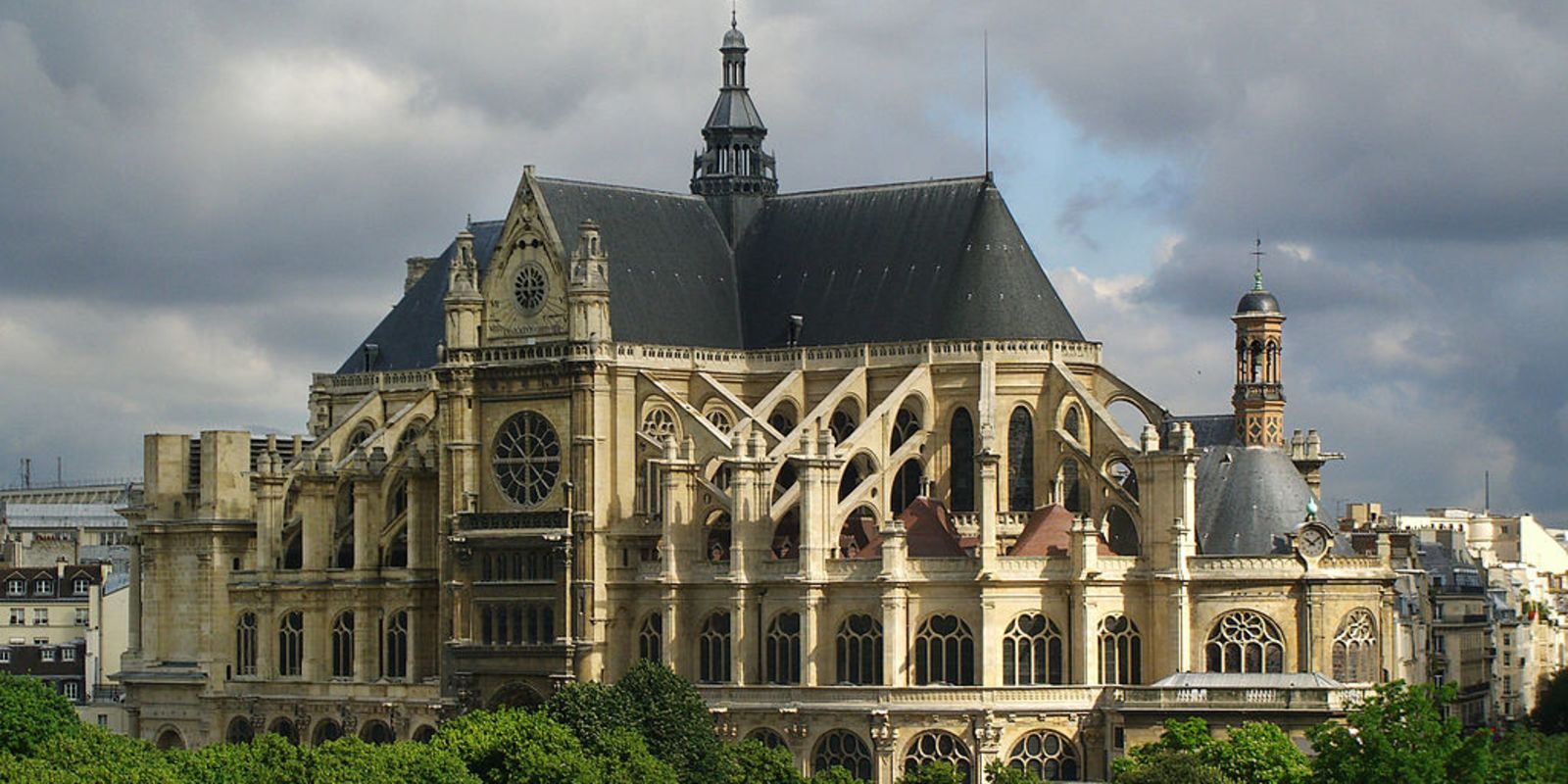Itinerary
Modern and historical, hype and traditional : Paris will be all of this as you go along this itinerary.

Almost a loop, this walk will bring you in many different parisian atmospheres :
… A rich and refined city, with its luxury “hôtels particuliers” (private or former private mansions the size of a building) and smart shops (such as the Mariage Frères tea house and museum),
… A trendy city, with its numerous shopping addresses in the Marais district,
… A traditional city, between gothic religious buildings, a medieval cloister and a hausmannian public garden,
… A modern and bold city, as exemplified by the Pompidou Center,
… And also a city for the people, made of simple pleasures, jobs and social initiatives.
Yes, all this in a single itinerary !
So there’s a lot to do, and we advice starting in the morning and completing the walk after lunch. The 4-hour duration is highly dependant on your choices (whether you want to visit such museum, or not ; whether you want to go to a restaurant for lunch, or not, etc.) so it’s more an average duration between a short version (the itinerary is doable in 2-3 hours) and a long one that can take up to a whole day.
10 stops
1. Saint-Eustache Church
The church became a parish church in 1223. It was a chapel dedicated to Sainte-Agnès, a Roman martyr. The construction of the current church began in 1532, the work not being finally completed until 1637. The name of the church refers to Saint Eustace, a Roman general of the second century AD who was burned, along with his family, for converting to Christianity.
The church is an example of a Gothic structure clothed in Renaissance detail. The front and rear aspects provide a remarkable contrast between the comparatively sober classical front and the exuberant rear, which integrates Gothic forms and organization with Classical details.
A Keith Haring sculpture made of silver stands in a chapel of the church in memory of the epidemic of AIDS deaths during the 1980s.
The organ is reputed to be the largest pipe organ in France, surpassing the organs of Saint Sulpice and Notre Dame de Paris.
Source : Wikipedia contributors, “Saint-Eustache, Paris“
2. Montorgueil Street
Lined with restaurants, cafés, bakeries, fish stores, cheese shops, wine shops, produce stands and flower shops, rue Montorgueil is a place for Parisians to socialize while doing their daily shopping. At the southernmost tip of rue Montorgueil is Saint-Eustache Church, the Centre Georges Pompidou and Les Halles, and to the north is the area known as the Grand Boulevards.
La Maison Stohrer at 51, rue Montorgueil, is one of the oldest (1730) bakeries in Paris. It was at this location that baba au rhum was invented.
(Source : Wikipedia)
3. Centre Pompidou
How can you miss it ? Since its opening in 1977, the Centre Pompidou has had over 150 million visitors.
It houses a vast public library, the Musée National d’Art Moderne which is the largest museum for modern art in Europe, and IRCAM, a centre for music and acoustic research.
Because of its location, the Centre is known locally as the Beaubourg. It is named after Georges Pompidou, the President of France from 1969 to 1974 who decided its creation.
The Centre was designed by Italian architect Renzo Piano; British architect Richard Rogers; and Italian architect Gianfranco Franchini.
The Place Georges Pompidou in front of the museum is noted for the presence of street performers, such as mimes and jugglers. In the spring, miniature carnivals are installed temporarily into the place in front with a wide variety of attractions: bands, caricature and sketch artists, tables set up for evening dining, and even skateboarding competitions.
Source : Wikipedia contributors, “Centre Georges Pompidou“
4. Des Archives Street
The rue des Archives is an animated street in the Marais district, and a pleasant walk with high architectural value.
The street is named after the “Archives nationales” (National Archives), partially located in the majestuous Hôtel de Soubise, which itself replaced the Hôtel de Clisson, whose XIVth century turrets remain visible today.
A word on the Billettes Cloister, “the house were God was boiled” – the only remaining medieval cloister in Paris, it was build onto an expiatory chapel commemorating a miracle involving the Jew Jonathas, who cut holy bread with a knife, causing it to bleed, then threw it in boiled water, causing it to fly away. Hence the name “the house where God was boiled”. Jonathas was sentenced to death for his crime and burned alive at the now Square du Vert-Galant.
5. Birds Kitchen Garden
The Birds Kitchen Garden is a 120-square meters collective kitchen garden surrounded by high walls and pided in 10 rectangles themselves pided in 3 parcels. Located near des Enfants Rouges market, it was created in 2004 as one of the shared gardens promoted by the municipality in order to revive neighbourhood life.
lt is open to the public when a member of the garden’s collective is present.
Source : translated from Wikipedia contributors, “Potager des oiseaux“
6. Picasso Museum
Located in the Hôtel Salé in rue de Thorigny, in the Marais district of Paris, it contained work by Pablo Picasso in all techniques and from all periods, and is especially rare in terms of its excellent collection of sculptures. Those, as well as drawings, ceramics and paintings, are complemented by Picasso’s own personal art collection of works by other artists.
Following the renovation works, the Museum will be even larger.
Source : Wikipedia contributors, “Musée Picasso“
7. Robert et Louise
This “restaurant of fire” is a paradise for meat lovers. One eats on old wood tables, near a fireplace where large beef ribs, that will then be handed over on board plates, are cooking. A warm and simple place in every sense at the very heart of the Marais district.
8. Mariage Frères Tea House and Museum
The shop (there are a few others in Paris) and its museum are a worthy stop. Teas are expensive but astonishingly good and there is an incredible choice. You’ll feel relaxed here – if you don’t mind a little colonial atmosphere, that is.
The museum features a lot of tea-related items, from teapots to wood furniture.
The Maison Mariage Frères has been crowned by Newsweek magazine as the best in the world for its Darjeeling teas.
9. Hôtel de Ville
The big (and stunning) City Hall of Paris (l’Hôtel de Ville) was build in the XIXth century from blueprints by architects Théodore Ballu and Édouard Deperthes.
Its neo-renaissance facade is largely inspired by the one of the previous palace, build between 1533 and 1628 – although Paris’s administration has been located at this spot since 1357 – but destroyed by fire during the Paris Commune in May 1871.
The Place de Grève, now called Place de l’Hôtel-de-Ville (since 1803) is a pedestrian square since 1982. It is here that Nicolas Pelletier, the first ever convict to be executed with a guillotine, found his death on April 25, 1792.
The Hôtel de Ville is the largest City Hall in Europe. Visits are only possible during the Journées du patrimoine.
10. Square of the Tour Saint-Jacques
This haussmannian garden surrounding the gothic XVIth-century Saint-Jacques bell tower is the first of its kind in Paris. The tower, one of the starting points for the Compostela pilgrim route, is not opened to the public. There is a weather station on the top platform.
Map, navigation, practical information, extra pictures and more are available on the Paris Parcours app.
